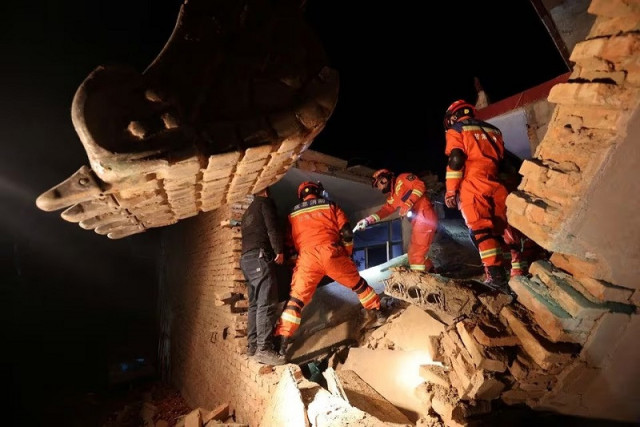Homes collapse as earthquake kills more than 100 in China's rural Gansu
Magnitude-6.2 earthquake hit Gansu and Qinghai, killing 127, injuring hundreds, and causing widespread damage

A magnitude-6.2 earthquake struck one of China's poorest regions just before midnight on Monday, killing at least 127 people, injuring hundreds and bringing down mud houses in remote villages that never stood a chance.
Chinese state media arriving at the sixth commune of Dahe village, one of the worst-hit areas in China's northwestern Gansu province, found many houses were either at risk of collapse, or had already crumbled to the ground, especially homes built from earth and clay.
"I've lived for more than 80 years and had never seen such a big earthquake," said an old man who was being carried out of his damaged home by rescuers.
More than 155,000 homes in Gansu were either damaged or destroyed.
At 11:59 p.m. (1559 GMT) on Monday, the quake rocked Gansu's Jishishan county, at a depth of 10 km (6.2 miles). The epicentre was 5 km from the provincial border straddling Gansu and Qinghai, where strong tremors were also felt.

PHOTO: REUTERS
Authorities have mobilised an array of emergency responses after the quake wrecked roads and infrastructure, triggered landslides, and half buried a village in silt. But rescue work has proved challenging in sub-zero temperatures, after a powerful cold snap swept across the country.
Earthquakes are common in provinces such as Gansu, lying on the northeastern boundary of the tectonically active Qinghai-Tibetan plateau. China's deadliest quake in recent decades was in 2008 when one of magnitude-8.0 struck Sichuan, killing nearly 70,000 people.
In Gansu, 113 were killed as of 1:00 p.m. Tuesday (0500 GMT), and 536 injured, authorities said.
The death tally in Qinghai stood at 14 with 198 injured, as of 4:50 p.m. (1250 GMT).
Officially, 20 people remained missing.
About 2,200 personnel from the Gansu provincial fire department and 900 from the forest brigade, as well as 260 professional emergency rescue workers, were dispatched to the disaster zone, the Xinhua news agency reported, adding that hundreds from the military and police were also deployed.
The province, which has allocated 20 million yuan ($2.8 million) to the local government for the emergency response, also sent supplies that included 2,600 cotton tents, 10,400 folding beds, 10,400 quilts, 10,400 cotton mattresses, and 1,000 sets of stoves.
County officials from Jishishan, with a population of about 260,000 people spread across numerous villages and townships, said the local government, lacking resources, had to rely on the provincial government. Gansu is among the poorest provinces in China.
Race against the cold
As the disaster area is in a high-altitude region where the weather is cold, rescue efforts are working to prevent secondary disasters caused by factors beyond the quake, Xinhua said.
The temperature in Linxia, Gansu, near where the quake occurred, was about minus 14 degrees Celsius (6.8 Fahrenheit) on Tuesday morning.
Although the 72 hours after a quake are the most likely time to rescue survivors, that will be shortened by the harsh weather, with trapped victims facing higher risk, it said.
Some water, electricity, transportation, communications and other infrastructure have been damaged.
Dozens of highways and rural roads were damaged amid multiple landslides, although no casualties were reported.
However, a major hydropower dam 50 km from the epicentre was unaffected by the quake. CCTV reported that the dam, on the upper Yellow River, was operating normally.
In a village in Qinghai, the quake triggered a mudslide that left many houses half-covered in brown silt. Rescuers have deployed drones, excavators and bulldozers to find and rescue survivors, local media reported.
Read Earthquake of 7.5 strikes Philippines, tsunami expected in Philippines and Japan
Tremors were felt as far as 1,000 km away in central Henan province, where local media outlets shared videos of furniture swaying in people's homes.
Woken up by the quake, residents left their buildings and drove to open areas for safety, local media outlet Jimu reported, showing a photo of people huddled in thick blankets outdoors.
Preliminary analysis shows that the quake was a thrust-type rupture, one of three above magnitude 6 to have struck within 200 km of the epicentre since 1900. The state media reported at least 32 aftershocks in the hour after the quake hit.
Gansu officials told reporters that the last strong quake of at least magnitude 5.0 to hit within 100 km of the epicentre was in 2019.
A total of nine aftershocks at magnitude 3.0 and above were recorded by Tuesday morning, two of which were at least 4.0 in magnitude.
About 3,000 km from Jishishan in Xinjiang region, another earthquake struck at 9:46 a.m. (0146 GMT) Tuesday, with a magnitude of about 5.5 and at a depth of 10 km.
On Tuesday night, a magnitude-3.1 quake hit Sichuan, with the epicentre at a relatively shallow depth of 8 km. No casualties have been reported.






1724148693-0/BeFunky-collage]_____-(24)1724148693-0-208x130.webp)











COMMENTS
Comments are moderated and generally will be posted if they are on-topic and not abusive.
For more information, please see our Comments FAQ